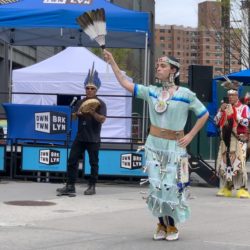Today, Brooklyn Bird Watch features a Heather Wolf photo of the White-throated Sparrow seen in Brooklyn Bridge Park. Wikipedia tells us: “The White-throated Sparrow ranks among the most abundant native birds during winter in North America.”
The White-throated Sparrow is a large sparrow with a fairly prominent bill, rounded head, long legs, and a long, narrow tail. The White-throated Sparrow has two color forms: white-crowned and tan-crowned. The two forms are genetically determined, and they persist because individuals almost always mate with a bird of the opposite morph. Males of both color types prefer females with white stripes, but both kinds of females prefer tan-striped males. White-striped birds are more aggressive than tan-striped ones, therefore, it is believed the white-striped females are more able to compete for the tan-striped males than the tan-striped females.
Although they look nothing alike and aren’t closely related, the White-throated Sparrow and the Dark-eyed Junco occasionally mate and produce hybrids. The resulting offspring look like grayish, dully marked White-throated Sparrows with white outer tail feathers.
The nest, built by female, is an open cup made of grass, twigs, weeds, and pine needles, lined with fine grass, rootlets, and animal hair.
I’m sometimes fascinated with how professional bird people will try to describe the song of a particular bird, ending with some strange letter combinations intending to represent the sound of that bird. I of course appreciate the attempt, yet I am often at a loss to imagine what sounds they are trying to describe, that is, especially if I have never heard that particular bird song myself. And I have to confess that when I recently read (at Cornell Lab) that the song of the White Throated Sparrow sounds like the National Anthem of Canada, I immediately thought to myself; “Yea, right, so what’s this ornithologist been drinking?”
So I listened to a recording of the White Throated Sparrow’s song and had to rethink my initial sarcastic thought because it really does sound like the bird could be singing the tune of “Oh-sweet-Canada”. Audubon says that the “Oh-sweet-Canada” rendition is probably the most appropriate because most White Throated Sparrows breed in Canada, but they’re also familiar winter birds across most of eastern and southern North America and California.
And something else interesting about the White-throated Sparrow’s song, taken from the Audubon Bird Guide App, reveals a rare, documented “dialect modification”.
“Male White-throated Sparrows usually whistle a simple yet elegant tune: Oh sweet Canada Canada Canada. But that’s not the song biologist Ken Otter has heard the local sparrows singing since 2000. Instead of the thin whistle typically ending in three syllables, male sparrows in Prince George, British Columbia, sang songs that ended in two syllables: Oh sweet Cana Cana Cana.
Between 2000 and 2019, this rare dialect went “viral,” Otter says, traveling more than 1,800 miles eastward into Canada and the United States. As it spread, the new two-syllable song replaced the widespread three-syllable song, the University of Northern British Columbia researcher and his colleagues reported in a study published in Current Biology.”
Other bird species have been documented altering the tunes they sing during mating season, because, it is thought, perhaps the inherited tune became boring to the female and so the males, out of necessity, started creating something new. Sounds a bit like some our own tactics doesn’t it?
"bird" - Google News
May 09, 2022 at 11:10AM
https://ift.tt/Vs8dxqf
Brooklyn Bird Watch: May 9 - Brooklyn Daily Eagle
"bird" - Google News
https://ift.tt/42JkxLV
https://ift.tt/UyfDaT6
Bagikan Berita Ini


















0 Response to "Brooklyn Bird Watch: May 9 - Brooklyn Daily Eagle"
Post a Comment